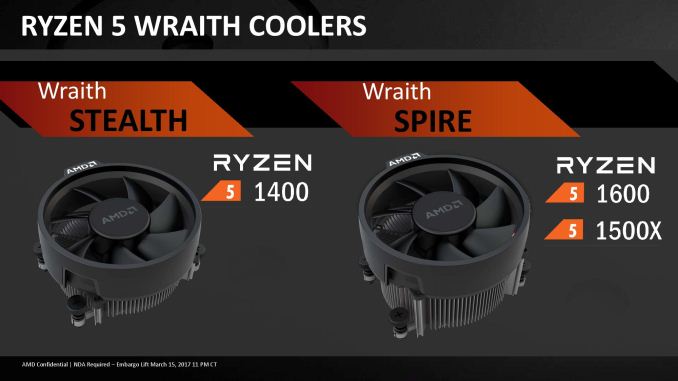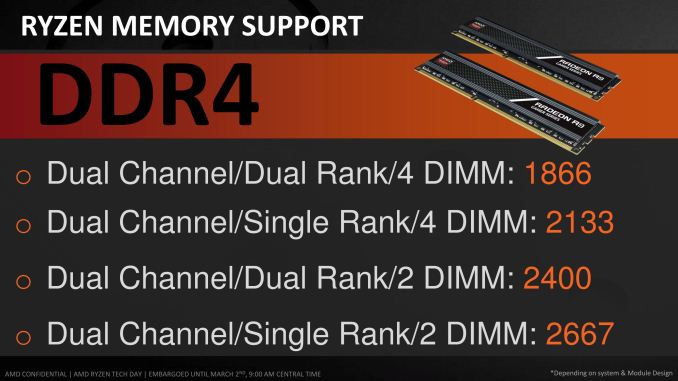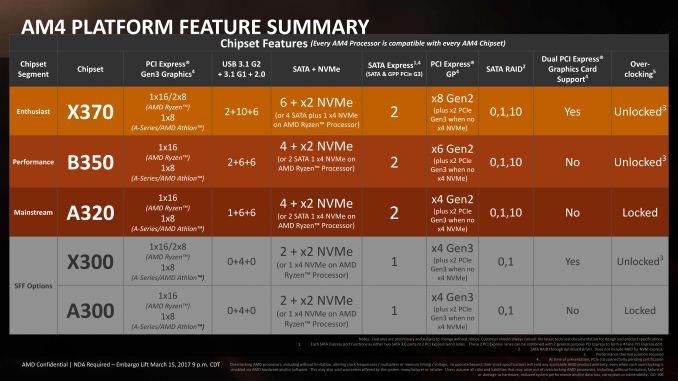The AMD Ryzen 5 1600X vs Core i5 Review: Twelve Threads vs Four at $250
by Ian Cutress on April 11, 2017 9:00 AM EST
Since the announcement of AMD’s mid-range offerings, it was clear that Ryzen 5 is going to have some major advantages over its direct price competition. For $250, the top Ryzen 5 1600X gives six cores and twelve threads of AMD’s latest microarchitecture. For the same price from Intel with a Core i5, you get four cores and no extra threads. Even though the Intel Core i5 based on Kaby Lake will have an instructions-per-clock advantage, it’s a hard hill to climb when the competition has 50% more cores and 200% more threads. In this review, we take the Ryzen 5 1600X and see if it smashes the market wide open.
Ryzen 3, Ryzen 5, Ryzen 7 (...Ryzen 9?)
Today marks the retail availability of AMD’s Ryzen 5 line of desktop processors. As the name suggests, Ryzen 5 sits between Ryzen 7, which was launched in March 2017, and Ryzen 3, to be launched in Q2 2017. The launch of Ryzen 7 last month was a return to the high-performance market for AMD, with its new x86 microarchitecture and core design built on GlobalFoundries 14nm process offering equivalent performance to Intel’s high-end desktop (HEDT) parts for under half-the-cost. Ryzen 5 is a step below that HEDT market, aiming more at mainstream users on more reasonable budgets.
One of the throwbacks to the Ryzen 7 launch for AMD was that the competition in that space was invariably overpriced to begin with – having had no competition for so many years, Intel was able to dictate the price and performance ratios without losing market share. While Ryzen 7 came out fighting in that market, ultimately it was up against a two-generation old CPU design from Intel, and not the latest, due to the way that Intel staggers its design cycle between mainstream and high-end processors. Ryzen 5, on the other hand, is coming out against processors that Intel has launched this year, on their leading design.
So while Ryzen 7 undercut the HEDT market by offering the same performance (in most cases) for half the price, Ryzen 5 can’t do the same. The midstream market is more price sensitive, and as a result AMD is launching Ryzen 5 at similar price points to Intel in this field. So while AMD can’t compete on price, it tackles the midstream market with more cores and more threads instead. Where Intel offers four cores, AMD offers six. Where Intel offers four threads, AMD offers twelve. This has implications for performance and power, which will be a part of this review.
(I'm joking about Ryzen 9 in the title to this section. No Ryzen 9 has been announced.)
The Ryzen Series
Without further ado, here is where the Ryzen families stand:
| AMD Ryzen 7 SKUs | |||||||
| Cores/ Threads |
Base/ Turbo |
XFR | L3 | TDP | Cost | Cooler | |
| Ryzen 7 1800X | 8/16 | 3.6/4.0 | +100 | 16 MB | 95 W | $499 | - |
| Ryzen 7 1700X | 8/16 | 3.4/3.8 | +100 | 16 MB | 95 W | $399 | - |
| Ryzen 7 1700 | 8/16 | 3.0/3.7 | +50 | 16 MB | 65 W | $329 | Spire RGB |
| AMD Ryzen 5 SKUs | |||||||
| Cores/ Threads |
Base/ Turbo |
XFR | L3 | TDP | Cost | Cooler | |
| Ryzen 5 1600X | 6/12 | 3.6/4.0 | +100 | 16 MB | 95 W | $249 | - |
| Ryzen 5 1600 | 6/12 | 3.2/3.6 | +100 | 16 MB | 65 W | $219 | Spire |
| Ryzen 5 1500X | 4/8 | 3.5/3.7 | +200 | 16 MB | 65 W | $189 | Spire |
| Ryzen 5 1400 | 4/8 | 3.2/3.4 | +50 | 8 MB | 65 W | $169 | Stealth |
Normally we see parts with with fewer cores having a higher clock frequency, however perhaps due to the voltage scaling of the design, we see a matched Ryzen 5 1600X in frequency to the Ryzen 7 1800X, but the rest of the Ryzen 5 family are offered at a lower TDP instead.
All the Ryzen 5 parts are unlocked, similar to the Ryzen 7 parts, and all four exhibit some movement in their ‘Extreme Frequency Range’ (XFR) mode, with the 1500X offering +200 MHz when there is sufficient cooling at hand.. AMD is going to offer some of these SKUs with their redesigned Wraith coolers, except the 1600X.
It is worth noting that the Wraith Spire for Ryzen 5 will not have RGB lighting, whereas the Wraith Spire for Ryzen 7 does use an RGB ring. OEMs will be able to use the higher-end Wraith Max stock cooler for their pre-built systems. AMD stated that at present, there are no plans to bring the Wraith coolers to retail as individual units, however they will keep track of how many users want them as individual items and regularly approach the issue internally.
To clarify some initial confusion, AMD has given me official TDP support numbers for the coolers. The entry level Wraith Stealth is 65W, the Wraith Spire is 65W for high-ambient conditions (AMD states this might be considered an '80W' design in low-ambient), and the Wraith Max is 95W for OEM builds using Ryzen 7 95W parts.
All the Ryzen 5 parts will support DDR4 ECC and non-ECC memory, and the memory support is the same as Ryzen 7, and will depend on how many modules and the types of modules being used. Recently companies like ADATA announced official support for AM4, as some users have found that there were memory growing pains when Ryzen 7 was launched.
Platform support for Ryzen 5, relating to PCIe lanes and chipset configurations, is identical to Ryzen 7. Each CPU offers sixteen PCIe 3.0 lanes for graphics, along with four lanes for a chipset and four lanes for storage. Chipsets can then offer up to eight PCIe 2.0 lanes which can bifurcated up to x4 (AMD GPUs can use chipset lanes for graphics as well, however at reduced bandwidth and additional latency).
Competition
The high-end Ryzen 5 1600X, at $249, is a shoe-in to compete against Intel’s i5-7600K at $242. Intel’s CPU is based on the Kaby Lake microarchitecture, and we’ve already shown in the Ryzen 7 review that by comparison Ryzen is more circa Broadwell, which is two generations behind. AMD won’t win much when it comes to single-threaded tests here, but the multi-threaded situation is where AMD shines.
| Comparison: Ryzen 5 1600X vs Core i5-7600K | ||
| AMD Ryzen 5 1600X |
Features | Intel Core i5-7600K |
| 6 / 12 | Cores/Threads | 4 / 4 |
| 3.6 / 4.0 GHz | Base/Turbo | 3.8 / 4.2 GHz |
| 16 | PCIe 3.0 Lanes | 16 |
| 16 MB | L3 Cache | 6 MB |
| 95 W | TDP | 91 W |
| $249 | Price (MSRP) | $242 |
Here we have twelve threads against four, at a 95W TDP compared to a 91W TDP (the 1600 is 65W, which looks better on paper). It is expected that for situations where a compute workload can scale across cores and threads that the AMD chip will wipe the floor with the competition. For more generic office workloads, it will interesting to see where the marks fall.
On the quad-core parts, there are several competitive points to choose from. The AMD Ryzen 5 1500X, at $189, sits near Intel’s Core i5-7500 at $192. This would be a shootout of a base quad-core in the Core i5 versus a quad-core with hyperthreading.
| Comparison: Ryzen 5 1500X vs Core i5-7500 | ||
| AMD Ryzen 5 1500X |
Features | Intel Core i5-7500 |
| 4 / 8 | Cores/Threads | 4 / 4 |
| 3.5 / 3.7 GHz | Base/Turbo | 3.4 / 3.8 GHz |
| 16 | PCIe 3.0 Lanes | 16 |
| 16 MB | L3 Cache | 6 MB |
| 65 W | TDP | 65 W |
| $189 | Price (MSRP) | $182 |
The reason why I didn’t pull out the Core i3-7350K there, at $168, is because the performance of the 7350K sits near the Pentium G4560, which is only $64 (and the subject of an upcoming review). That all being said, the $168 price of the i3-7350K matches up to the $169 price of the Ryzen 5 1400, although the 1400 has double the cores and double the threads of the 7350K.
Chipsets for Ryzen 5
The chipsets for AMD’s AM4 CPUs come in three main forms: the high-end X370 designed for premium Ryzen 7 systems and multi-GPU gaming (or multi-PCIe card workstations), mid-range B350 motherboards that still support overclocking but are more targeted at Ryzen 5 systems with a single graphics card, and the more budget range A320 which does not have overclocking and will be a fit in for Ryzen 3 later this year.
We are now at a point where the motherboard manufacturers are swimming in AMD motherboards, and distributors are building stock of various models. For Ryzen 5, AMD is pitching the B350 chipset based motherboards as a suitable solution, especially when compared to Intel’s B250 motherboards for Kaby Lake processors.
The B350 configuration matches that on the X370, save for a couple of PCIe lanes from the chipset and the focus on a single GPU.















254 Comments
View All Comments
lefty2 - Tuesday, April 11, 2017 - link
Yeah, also with the RX 480 the i5 7400 scores better then i5 7600 (by a huge margin)! That makes no sensesharrken - Wednesday, April 12, 2017 - link
AdoredTV did a very interesting video about exactly this issue, called "Ryzen of the Tomb Raider". In pretty extensive testing they show that something is definitely wrong with Nvidia cards in DX12 on Tomb Raider.https://www.youtube.com/watch?v=0tfTZjugDeg
On a Ryzen 1800X system, crossfire RX 480's beat out an overclocked Titan X, 90fps on the 480's and only 80fps on a Titan X - which is just ridiculously wrong when you look at the relative GPU power.
Some other people have run more tests, and a similar thing is happening in The Division, so it seems highly likely that Nvidia has some strange issues somewhere along the line with DX12.
https://www.reddit.com/r/Amd/comments/62n813/inspi...
milli - Wednesday, April 12, 2017 - link
It's also happening in Battlefield 1, Deus Ex: MD & Total War: W.https://www.computerbase.de/2017-03/amd-ryzen-1800...
Are nVidia drivers not detecting Ryzen CPU's correctly or is it foul play?
mdw9604 - Thursday, April 13, 2017 - link
Poor AVX implementation /w AMD and the driver.milli - Thursday, April 13, 2017 - link
What has AVX to do with nVidia's DX12 drivers???bug77 - Tuesday, April 11, 2017 - link
Really great job not throwing intel power consumption in there for comparison. /sIan Cutress - Tuesday, April 11, 2017 - link
Mainly because that part of the discussion was purely to do with CCX arrangement and core loading.But sure, because you asked so nicely. /s They've been added.
bug77 - Tuesday, April 11, 2017 - link
Thanks.Phiro69 - Tuesday, April 11, 2017 - link
Could you comment on your Chromium Compile benchmark a bit; I'd like to use it as part of a pitch on why our compile farm needs replacing (e.g. "look what a $249 cpu can do").What OS did you build under, I'm guessing Windows 10 from your earlier statements in the full article?
Did you follow these directions for the most part? https://chromium.googlesource.com/chromium/src/+/m...
If so (and you used Windows 10), then you used Visual Studio? Which version and which license of VS?
Thanks! Great review!
Ian Cutress - Tuesday, April 11, 2017 - link
Win 10 x64 Pro v1607, Build 14393.953. VS Community 2015.3 with Win10 SDK. I bascially followed the instructions in that link. :)